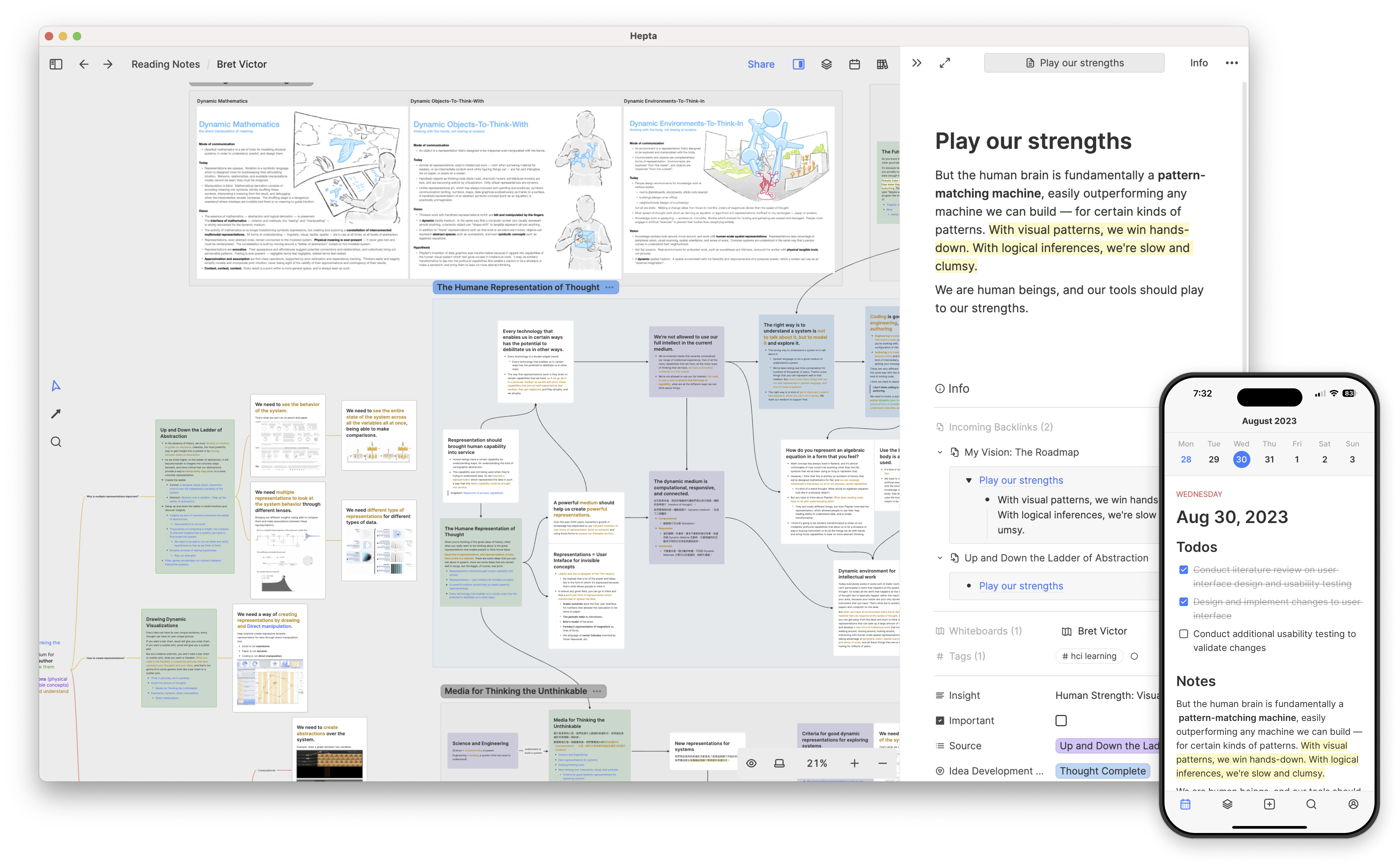
This article provides an introduction to Heptabase, a visual note-taking software. It covers the basic features of Heptabase and aims to assist new users.
Disclosure: I've joined the Heptabase team as a full-time employee since September 2023, so the introduction might be subjective. However, as an active user since January 2022, I believe this introduction can be helpful in various ways.
What is Heptabase?
Heptabase is a visual note-taking tool that helps you make sense of complex topics.
It allows you to utilize cards, whiteboards, and other elements for learning, researching, or planning. Think of it as a large whiteboard where you can view all your Notion or Evernote notes simultaneously.
Since there aren't many products like Heptabase, the best way to grasp its functionality is by starting a free trial and testing it yourself. However, if you'd like to learn more initially, you can continue reading the following paragraphs!
Core Elements of Heptabase - Cards & Whiteboards
First, let’s discuss the two core elements of Heptabase: Cards and Whiteboards.
If you haven’t used any similar visual note-taking software before, you might consider “cards” and “whiteboards” as the more common “pages” and “folders” found in other tools.
Once you understand the pairing and usage of these two elements, you can easily create a content hierarchy that can be beneficial to you!
Card
Feature-rich Card Editor
The card is the most basic element in Heptabase, where you can place a variety of content, such as simple text, three levels of headings, to-do lists, ordered and unordered lists, collapsible toggle lists, tables, codes, math formulas, as well as pictures, videos, and audio files.
These different types of content are all “blocks” within each card. With the combination of these blocks, you can freely add any content you want to each card.
And the operation is very simple. Just type a slash '/', and you can call up these options. At this time, you can also type a keyword to search for the option you want. For example, typing “im” will automatically suggest “image” for inserting a picture.
Every Card Has a Title and Text
The first line of each card is its title. It can be linked or referenced by other cards in the form of hyperlinks. Through the hyperlink, I can easily establish a relationship with other cards within the card.
Whiteboard
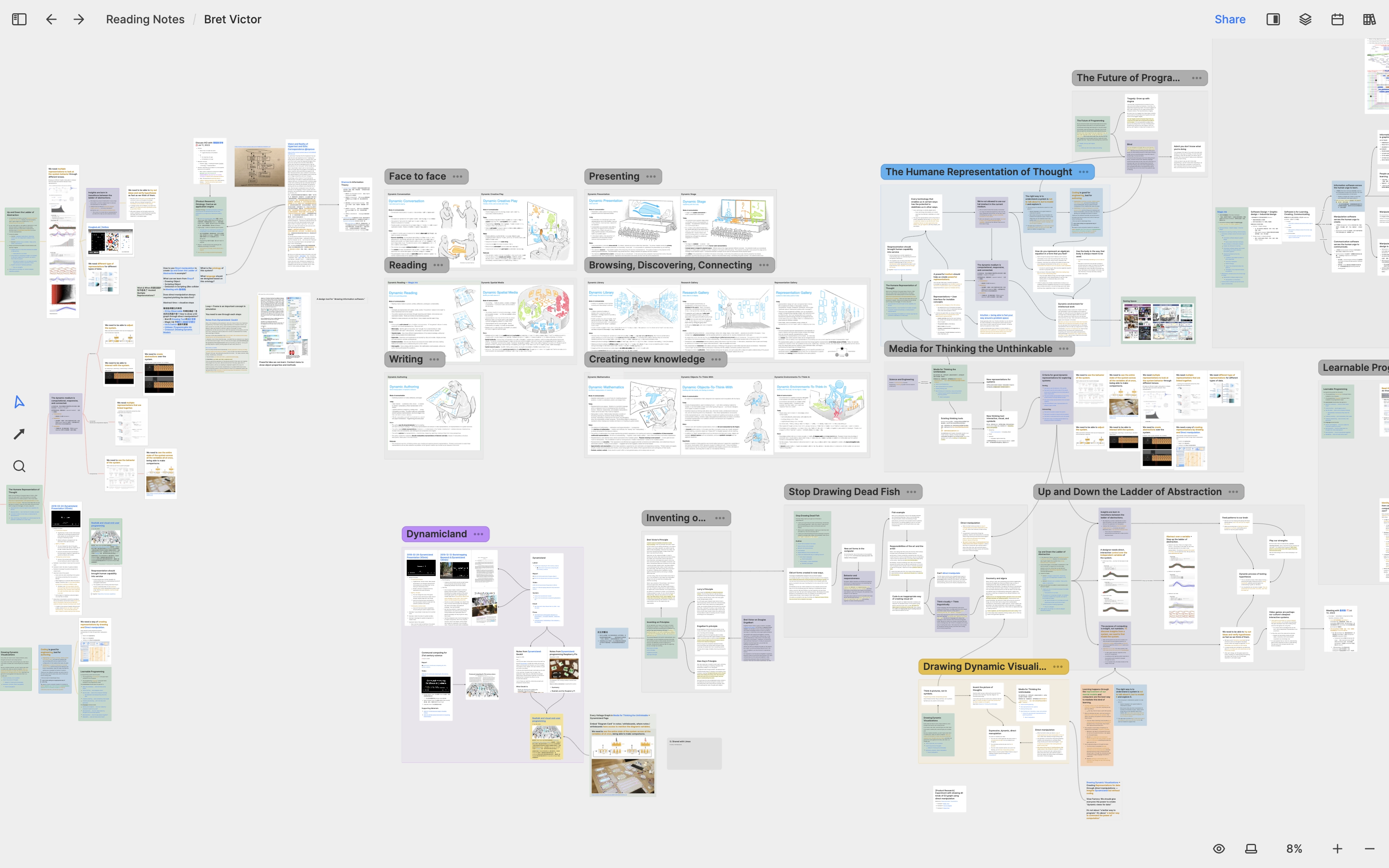
The Whiteboard is the main place inside Heptabase for collecting, organizing, and using cards. In Heptabase:
- You can create an unlimited number of whiteboards
- Each whiteboard can contain an unlimited number of sub-whiteboards
- Each whiteboard and sub-whiteboard can contain an unlimited number of cards and other whiteboard elements
When I introduce Heptabase to my friends, I describe the whiteboard as a thematic folder. For example, I have a main whiteboard titled My Knowledge Base, which is the entry point I use most often. Inside this whiteboard, there are many thematic whiteboards (sub-whiteboards) that interest me, such as Productivity Tools, AI, Blockchain & Crypto, Business, Photography, and so on.
Inside each whiteboard, I place relevant cards according to the theme of that whiteboard. For instance, in the Productivity Tools whiteboard, I put a variety of text cards related to Productivity Tools that I have written, or I might create separate sub-whiteboards for specific productivity tools that I particularly like to use. As for the Blockchain whiteboard, it might contain important whitepapers and technical documents in PDF form, accompanied by my written notes on the side.
However, as these items gradually accumulate, things can start getting messy. To allow users to arrange and organize content in each whiteboard according to their preferences, Heptabase offers various types of whiteboard elements. Users can flexibly mix and match them, assembling a whiteboard that suits their ideal layout and organization.
Heptabase’s Whiteboard Elements - Text element, Media element, Mindmap, Section
Text element
Sometimes, in Heptabase, you might need something like a sticky note to supplement your thoughts or annotate a specific card. In these situations, Heptabase’s text element comes in handy. You can create one anywhere on the whiteboard by right-clicking and selecting Text, which then prompts a transparent input box.
However, this box is more than just for typing text. After multiple iterations, such a text element can hold various content and can also change its background color. It works almost like a card, as shown in the image below:
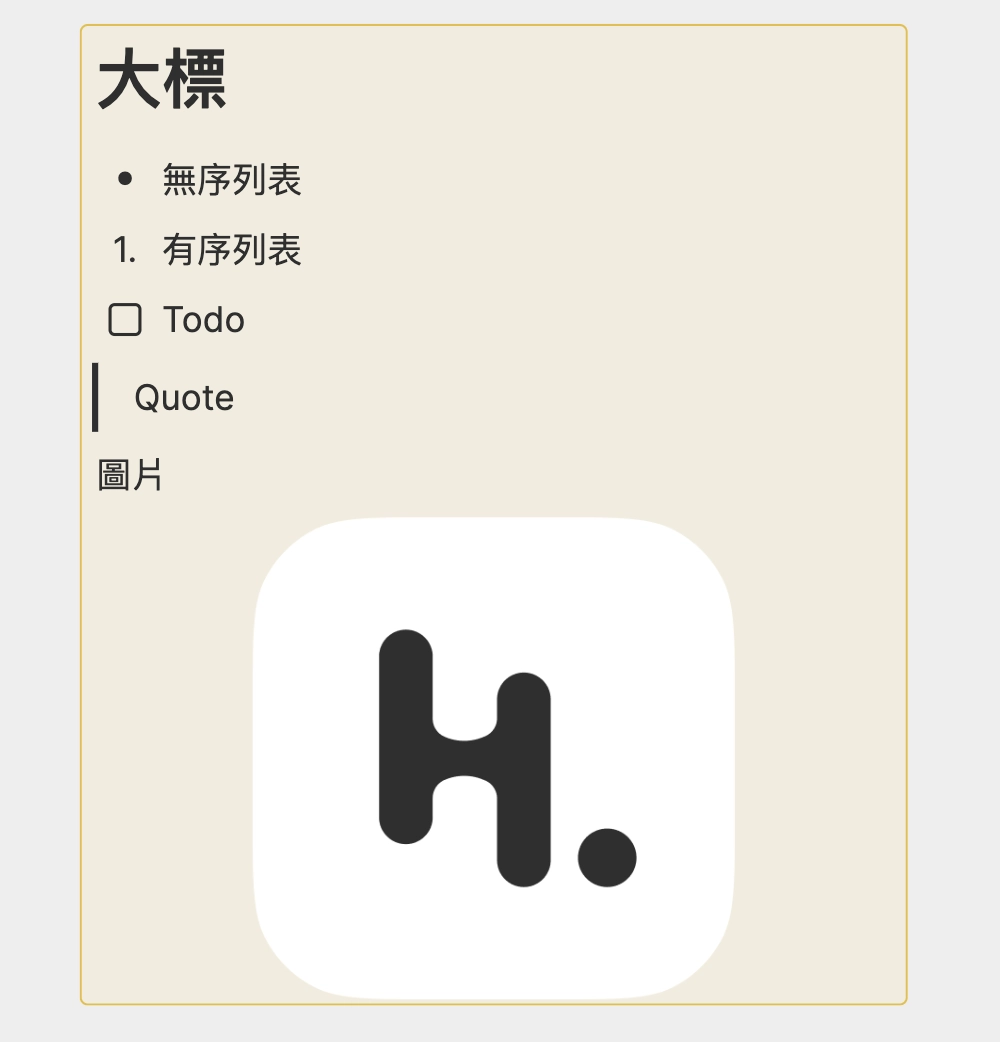
So, what’s the difference between a card and a text element? Why have this additional layer?
From my understanding, the key differences between these two are:
- Cards can be reused across different whiteboards, so they can be referenced, globally searched, and tagged.
- Text elements are exclusive to the current whiteboard and can only be searched within the whiteboard.
For me, if there’s a concept I anticipate reusing in the future, I would use a card.
If something is there solely to make the current whiteboard more comprehensible and I don’t want it to constantly show up in future searches, then I’d use a text element.
For example, some of my complex whiteboards might require colors to distinguish the states or importance of cards. But these rules might be forgotten after a while, so I’d use the text element to write down the rules at the start point of the whiteboard. That way, each time I enter the board, I know how to use it.
Media Element
Aside from text, you can freely add images, videos, and audio elements to the whiteboard in Heptabase. You can drag and drop files directly from your computer into Heptabase or use the copy-and-paste method.
Additionally, media elements added to the whiteboard can establish connections with other elements on the board.
For me, I prefer to put things I only want to see on this particular whiteboard through media elements, instead of placing them into cards. These might be illustrative images, reference notes, screenshot archives, and so on.
Mindmap
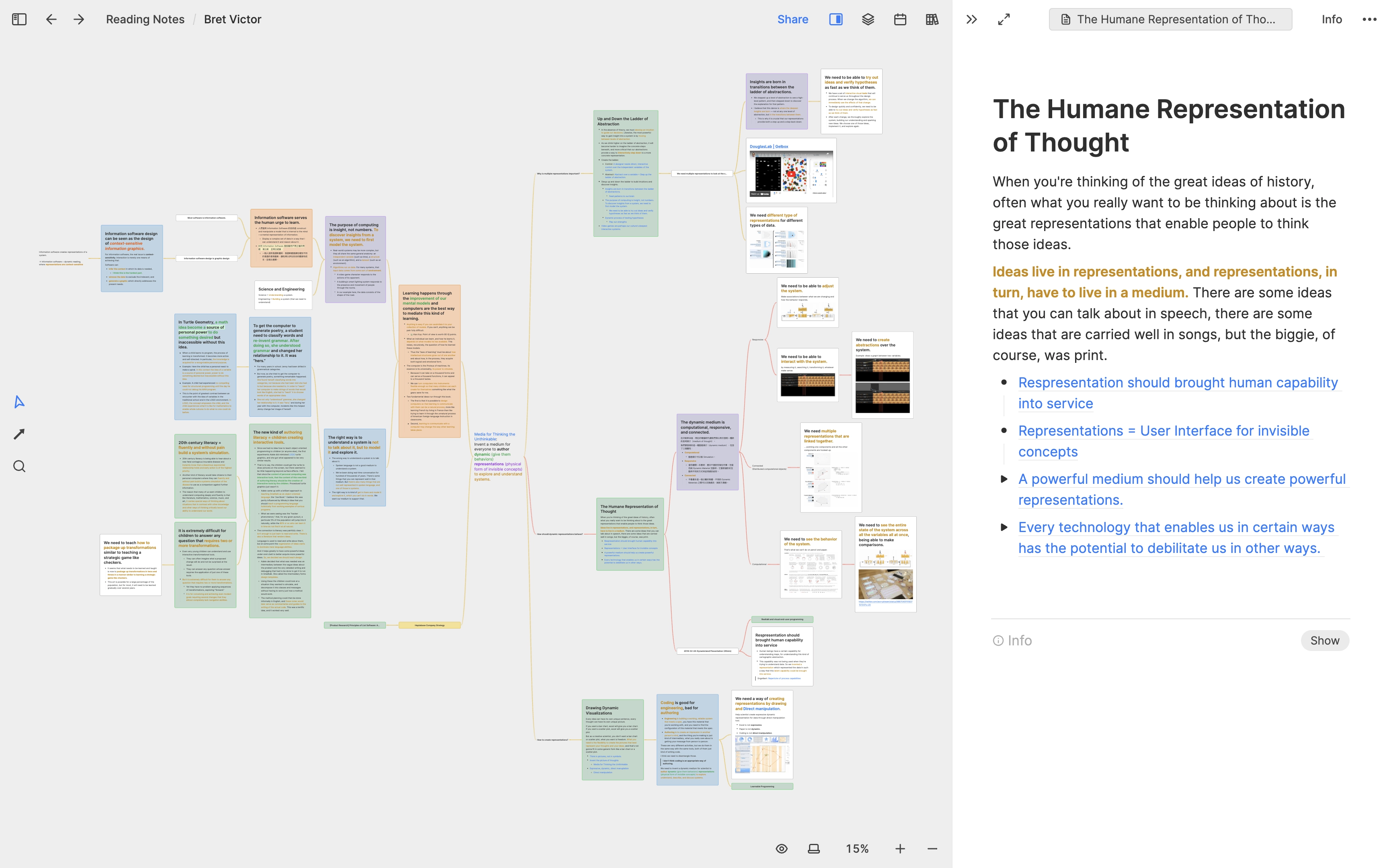
The mindmap feature launched in 2023 is another whiteboard element that perfectly complements cards.
Currently in Heptabase, the mindmap feature is not fully completed, yet it can already accomplish the following:
- You can choose between pure text nodes or card nodes
- You can expand card nodes, and the layout on the screen will automatically adjust
- You can freely drag nodes under other nodes
- You can freely drag cards on the screen to a mindmap to become a node
Out of these functions, I believe the most important ones are “automatic layout adjustment” and “freely drag and change structure”. Together, they create a wholly stress-free experience, allowing me to easily go “from bottom to top” in learning concepts from fields completely unfamiliar to me.
For example, recently I had to research a completely new field for work. Before the mindmap, I would use cards to record what I read online and then organize them. However, with the tree outline structure of the mindmap, I can quickly list the most important points in the field and the sub-items under these points.
When I read other contents and find that what I organized earlier needs to be adjusted, I don’t need to arrange the paragraphs on the cards anymore. I simply have to drag a node under another node, which changes the structure.
In this process, if I find substantial information in certain nodes, I can turn any text nodes into card nodes at any time. The card node on the mindmap then becomes content that can be reused elsewhere.
Moreover, a mindmap can make better use of screen space. Most of the outlining software I’m familiar with are vertical lists, which don’t maximize the horizontal screen’s space. But a mindmap placed on the whiteboard can utilize more screen space and, in turn, hold more information.
With the mindmap, I feel better able to organize the content of the whiteboards in Heptabase. It is a feature I highly recommend.
Section
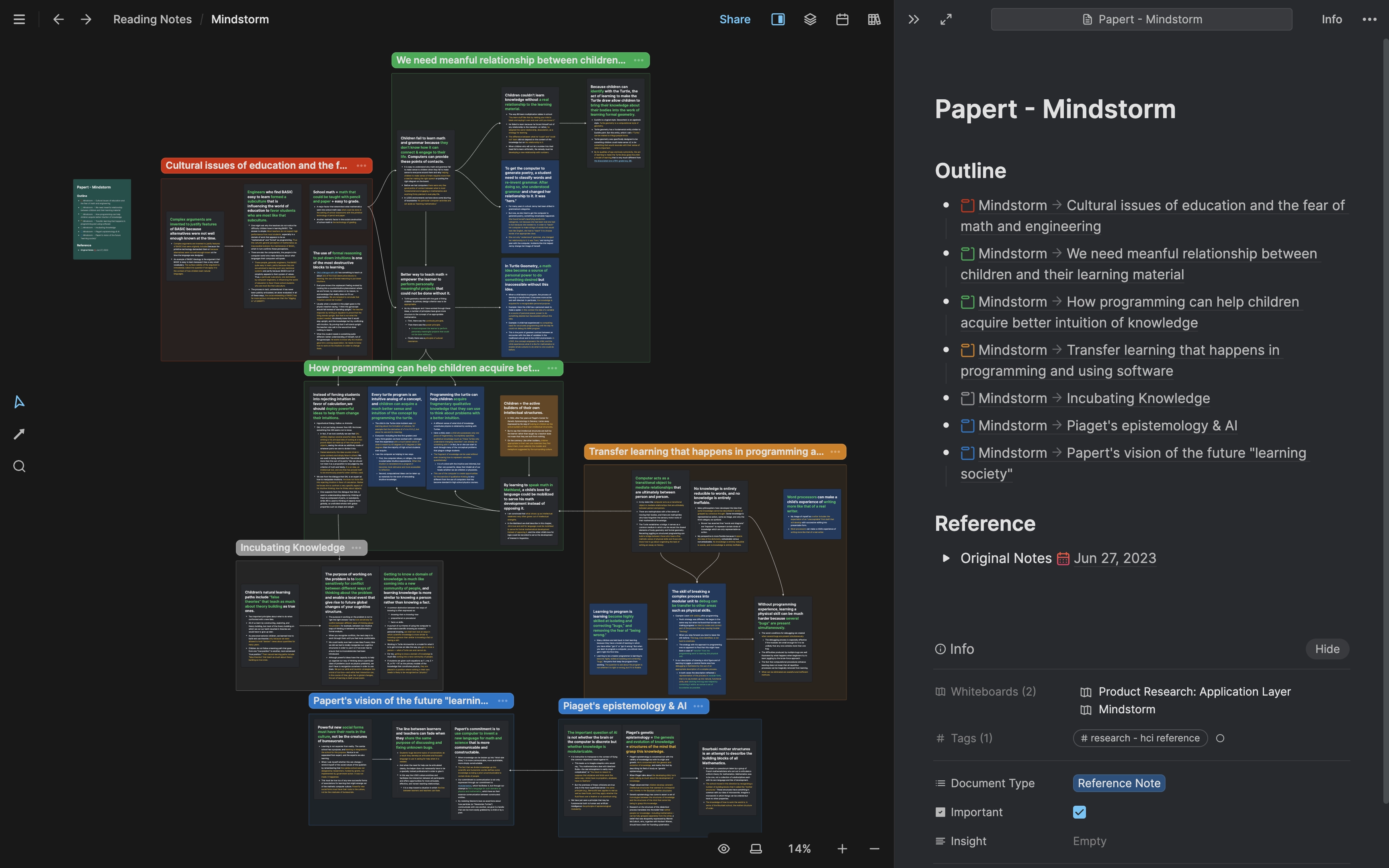
As you gradually accumulate boards and content in Heptabase, you’ll sometimes want to group a small cluster of cards together to form a section. For example, in my Personal Knowledge Management system, I have five stages: exploration, capture, development, refinement, and communication. They are all interconnected and I wanted to put the cards associated with these five stages on the same board while having a visual distinction. At this point, the section becomes the most suitable whiteboard component for me to use.
You simply need to select the cards you want to group into a section together, then right-click to create a section directly based on the occupied area of these cards. Once the section is set up, when you move it, all the cards inside the section will move along with it. Furthermore, you can give a name to the section or change its background color.
So what’s the difference between a whiteboard and a section, both of which can “contain some cards”?
In my view, a whiteboard is more about the logical hierarchy, just like a folder. cards in a particular whiteboard belong to the topic of that whiteboard.
But sections are more concerned with the visual relationship. You can create several different sections within the same whiteboard using different visual elements such as frames, colors, and lines to handle the relationships among multiple groups at once.
Additionally, sections have a hidden feature. When you zoom out the whiteboard to a smaller scale, you may not be able to see the details of each card clearly. However, the section titles are enlarged, allowing you to quickly grasp the big picture and easily locate the area you want to focus on, even when navigating a complex whiteboard filled with a large number of cards, as long as your sections are properly distinguished.
Heptabase's Visual Aids - Arrows, Connections, Colors
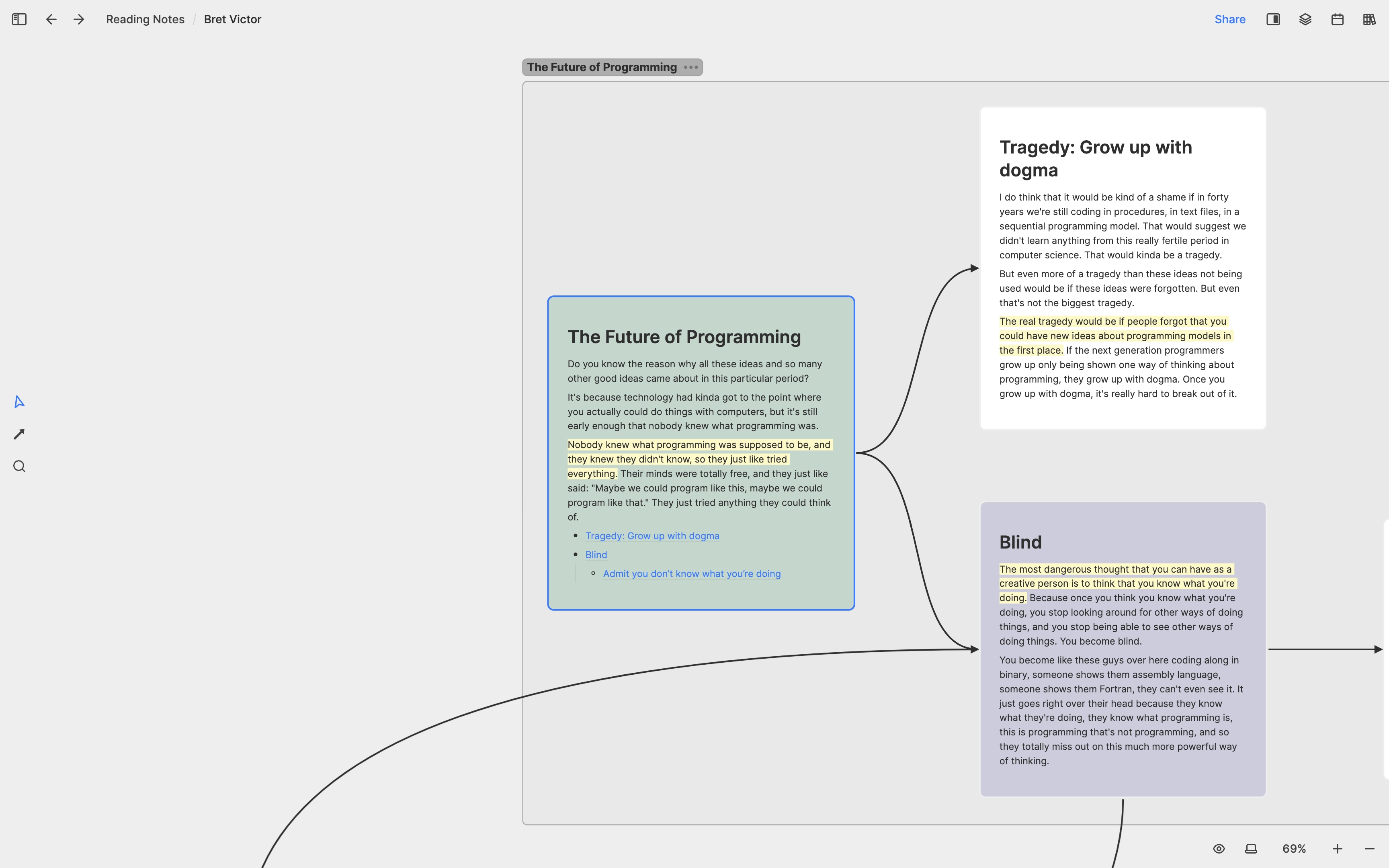
Apart from content cards, texts, sections and sub-whiteboards, Heptabase’s whiteboard feature comes with purely visual aids: arrows, connections, and colors.
Currently, there are three types of arrows: regular, bold, and arrowless. For connections, there are curves, straight lines, and elbow curves.
Moreover, regardless of whether it is cards, whiteboards, sections, connections, or other content, you can choose from different colors (currently, eight colors each are available for light and dark modes).
By utilizing these visual aids, you can easily establish the relationships between different objects on the whiteboard. For instance, I once posted a Twitter thread about my job hunting experience in early August, where I mainly used a whiteboard to write down my resume, past experiences and abilities, and other relevant content. With the help of colors and connections, I was able to make the key points of the content more prominent.
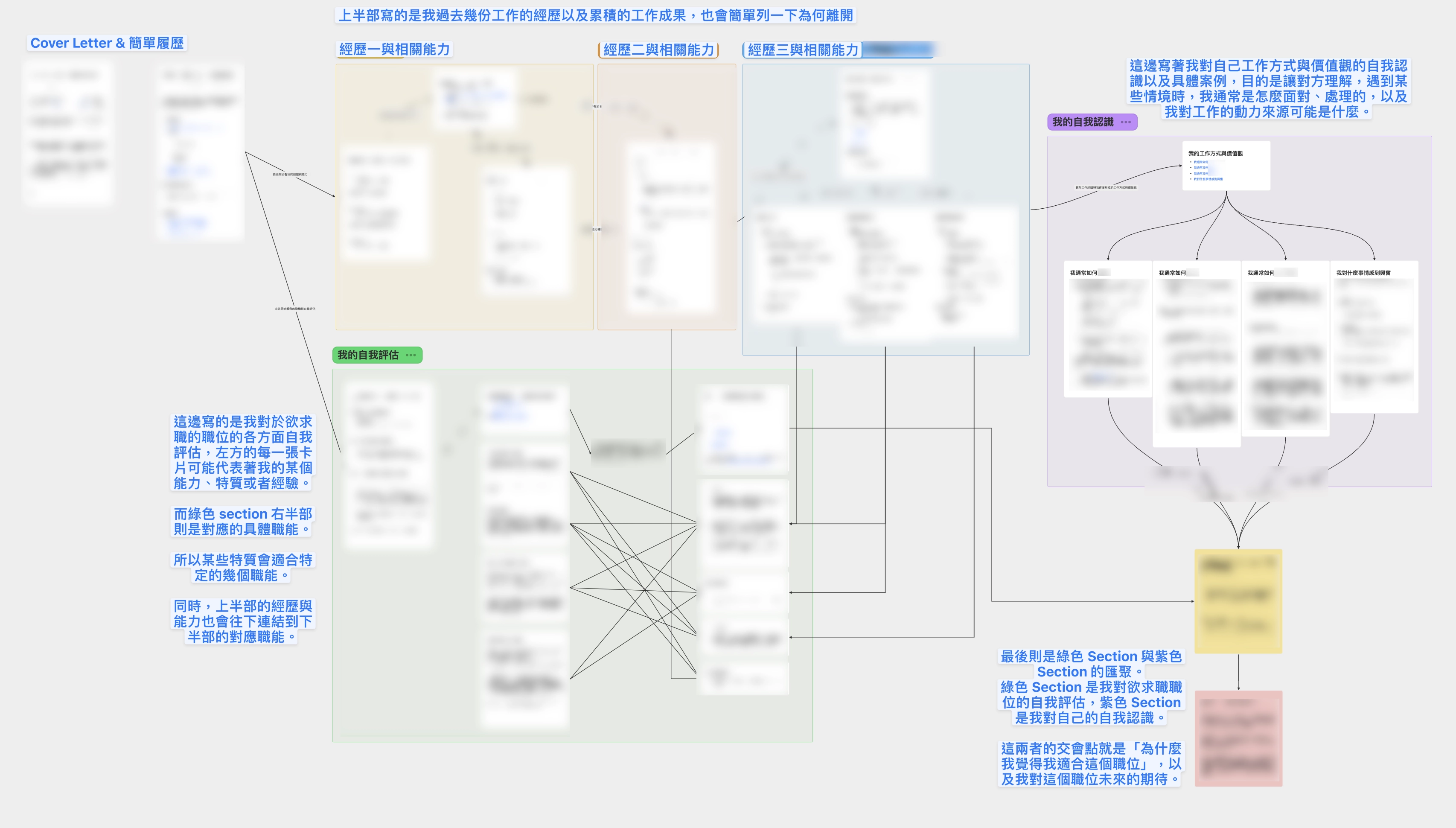
To me, the importance of these visual aids is no less than the actual content. When I add some colors and connections between the content, I also reexamine the logical relationships between the contents. This serves as another opportunity for me to refine my whiteboard.
Heptabase’s Card Management and Search: Card Library, Tag, Search
When you have more and more cards, you may notice a few things:
- You want to find certain cards faster.
- You want to filter or classify cards in more detailed ways.
- You want to manage cards beyond the classification method of the whiteboard.
At this point, the following three functions can help you organize and find your cards more freely.
Card Library

The card library is a card management station within Heptabase, where you can view every card arranged chronologically once you click into it.
At the top of the card library, there is a row of filter options with several distinct selections:
- All Cards: View all cards.
- Uncategorized: All the standalone cards that do not belong to any whiteboard and do not have tags.
- PDF: All PDF files.
- Tags: Filter cards according to tags.
- Whiteboards: Filter cards within a specific whiteboard.
- Custom: Users can customize filters based on tags, whiteboards, and keywords. You can also save the filters.
After selecting the desired card, you can directly select in the card library and a menu will appear. At this point, you can choose to:
- Open these cards in a new tab for viewing or writing.
- Export them as markdown files.
- Attach certain tag labels.
- Insert them into a specific whiteboard.
- Delete them.
As can be seen from the above, the card library is somewhat akin to a card transit station, where you can quickly find a “group” of cards you want based on certain criteria and then manage and organize them in any way you prefer.
Additionally, there’s a small broom button at the top of the card library. It allows you to delete completely blank cards that do not belong to any whiteboard. It is a very thoughtful and practical feature as it greatly reduces the friction to create a card because there is no issue with leaving it temporarily empty.
Tag
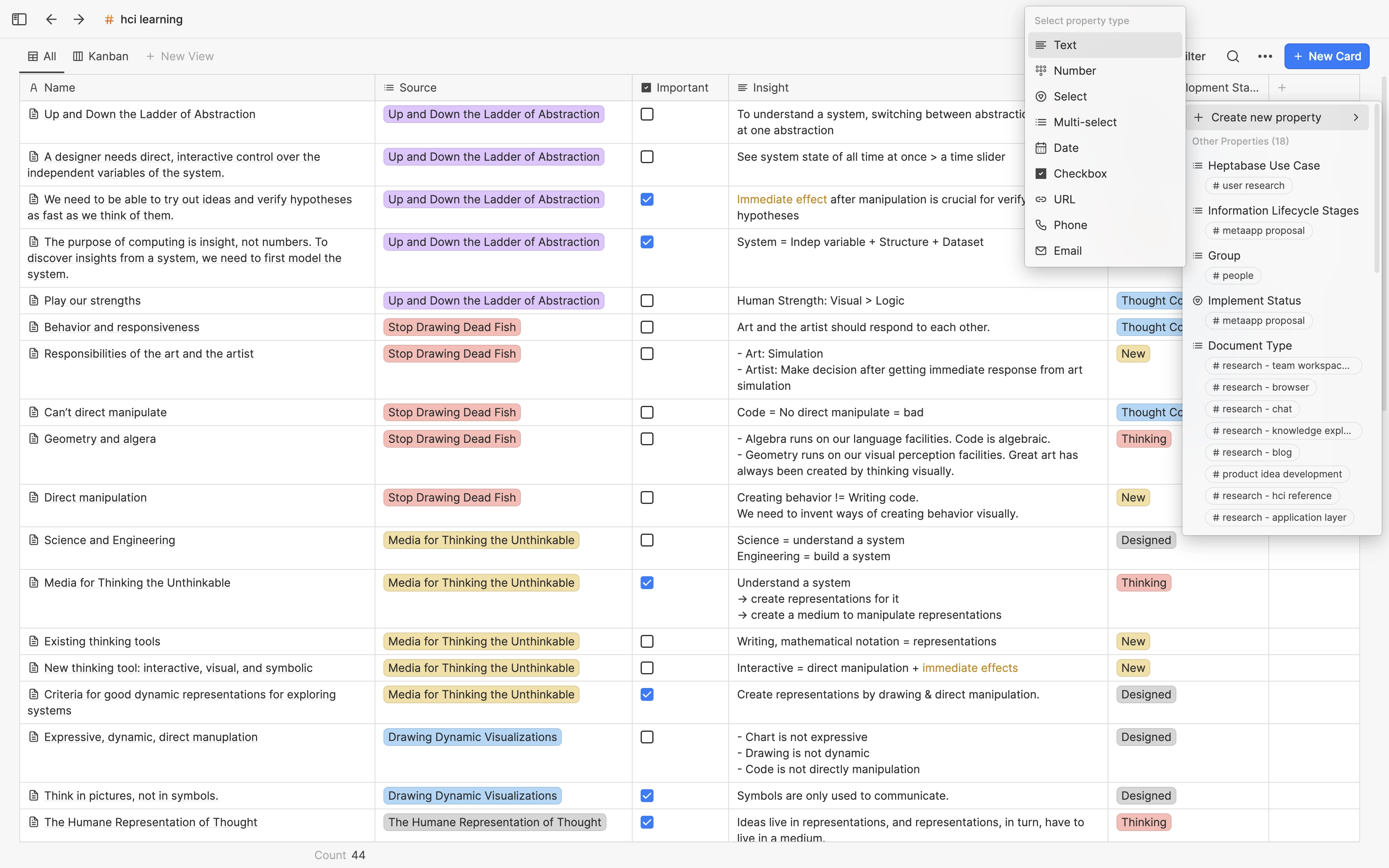
In addition to managing and filtering cards through the Card Library, Heptabase also offers the function of tagging cards, and each tag can set its corresponding properties.
For example, the image above is from an official Heptabase Tag chart. This tag is “hci learning” (Human-Computer Interaction), so any card tagged with this will show up on this screen.
But for this tag, you can set a variety of different properties, such as single selection, multiple selections, checkboxes, plain text, numbers, dates, URLs, etc. So, a card with an HCI tag can denote its data source, subcategories, importance, and what insights it provides.
Through this tag-properties correspondence, you can add more metadata to each card. You can then further filter or switch to a Kanban view.
Tag - Kanban view
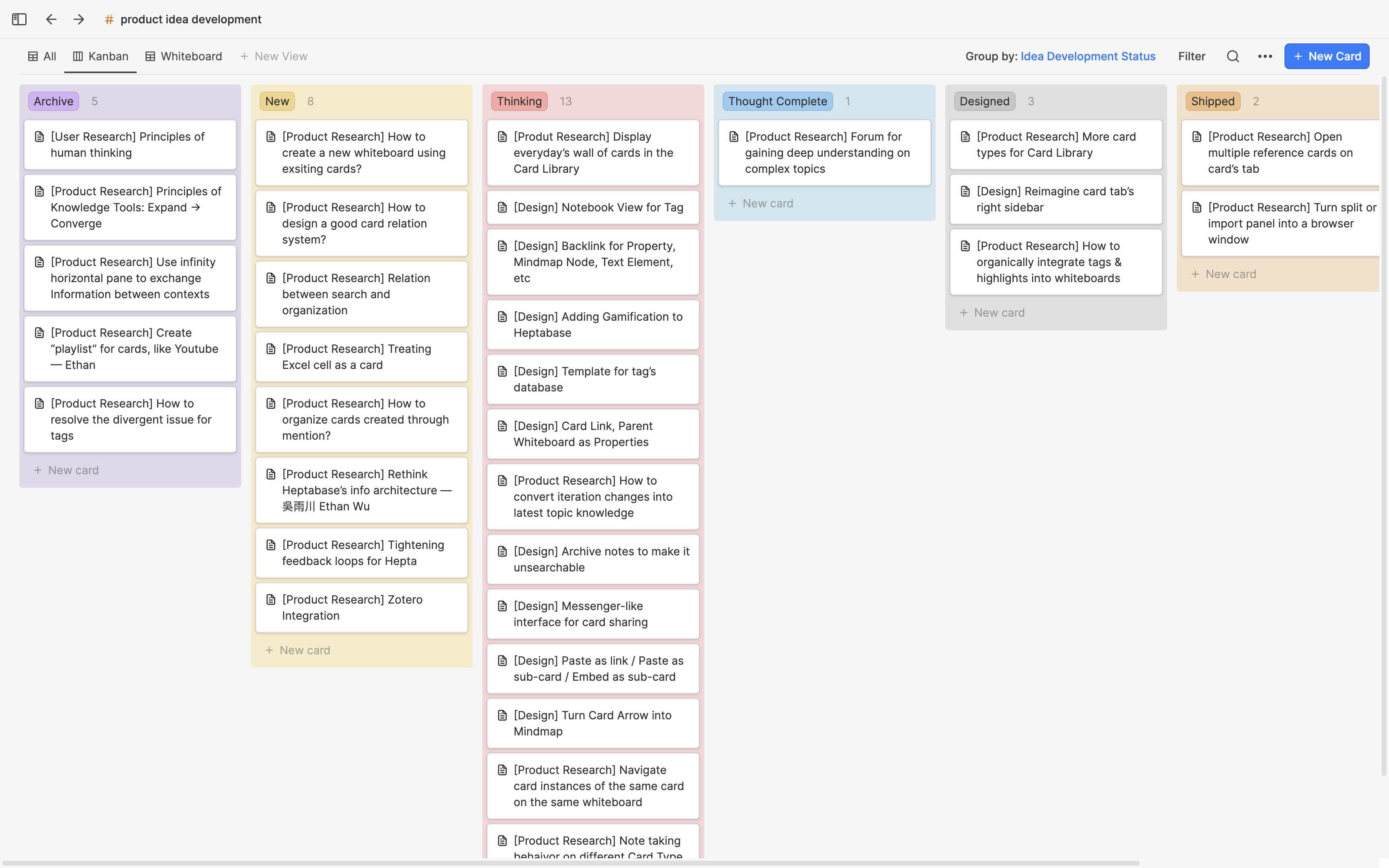
When you have a tag and it contains some single selection properties, you can switch to the Kanban mode. In the image above, the “Idea Development Status” property within the “product idea development” tag is used as the filter requirement for the Kanban board. At this point, different statuses such as New, Thinking, Designed, Shipped, Archive, etc., can be converted into the Kanban mode.
I often use the Kanban mode when handling cards that follow a clear workflow. For example, I have an “articles” tag, which contains a “status” property. I distinguish between different states such as “Inbox, Working, Paused, Done”, etc. With the Kanban view, it’s very convenient to see which cards are at which stage, and which cards I’ll need to handle next.
With the addition of the Kanban view, Heptabase now has some project management capabilities. While it may not be as comprehensive as professional software, it’s more than sufficient for managing the status of different cards.
Search
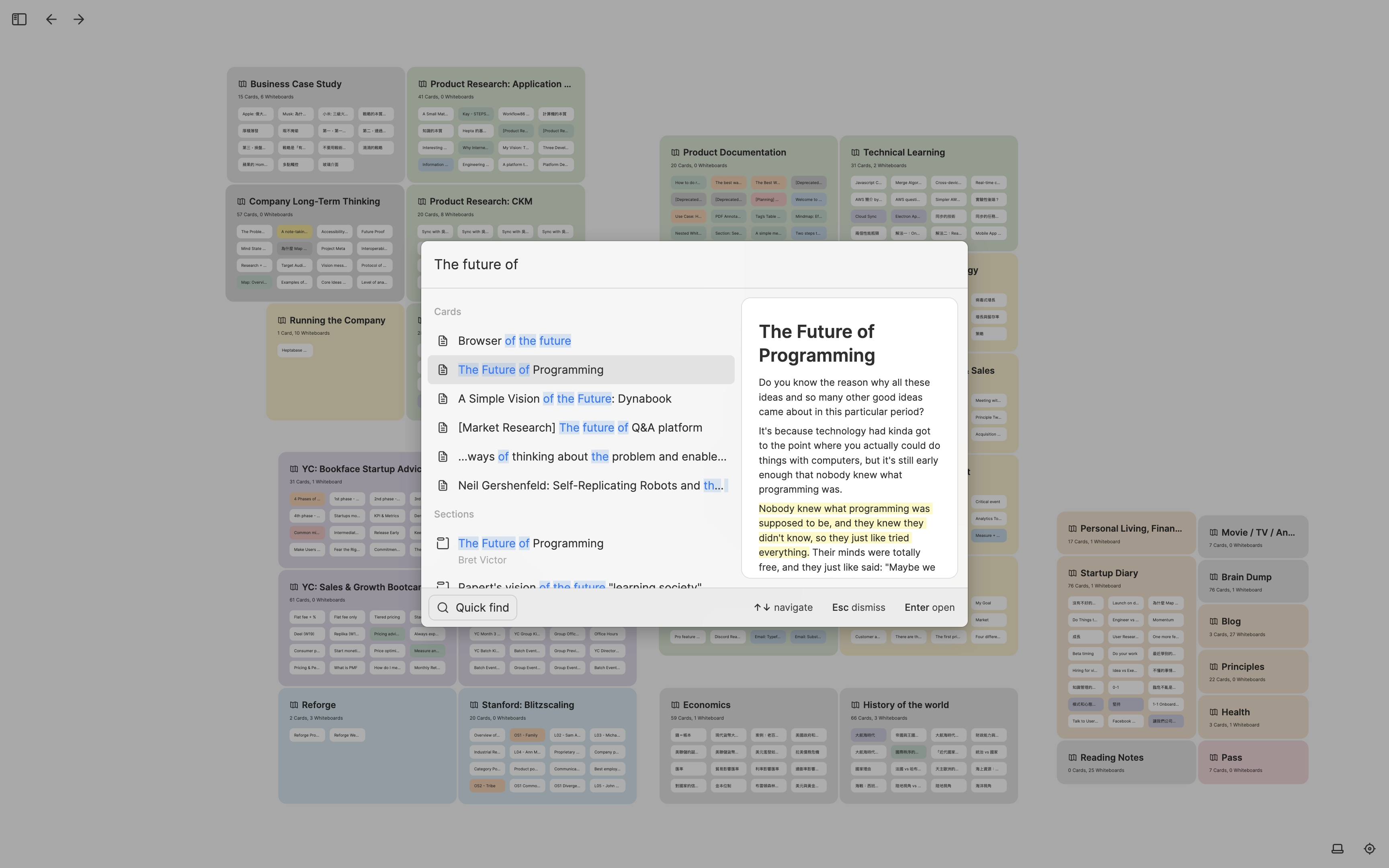
The previously mentioned card library and tag can be likened to knowing that you have a group of cards placed in a certain drawer. Consequently, you can quickly find that drawer, open it, and retrieve the cards.
But often, you may not remember whether you have a certain card or where you have placed your cards. In this case, you would use the search function of Heptabase.
Currently, the two most commonly used search methods in Heptabase are:
- Global Search (Cmd/Ctrl + O)
- Search within the whiteboard (Cmd/Ctrl + P)
I use both of these methods almost daily, as they each correspond to different situations.
Global Search
Global search can be used in any view in Heptabase. Once you initiate the search, a small box will appear. Enter the search string, and the corresponding content will appear. Upon clicking on it, you can immediately edit this card or enter a specific whiteboard or tag.
I typically use this feature in the following two scenarios:
- I want to find a card that I vaguely remember but am not sure where I placed it.
- I need to quickly navigate into a specific whiteboard or tag.
Search Within the Whiteboard
The second method, searching within the whiteboard, is the one I use more frequently. This search method will only search the current whiteboard. Once you click on the search result, the view will automatically jump to that card or whiteboard element.
I usually use this feature in the following two scenarios:
- I have just entered a somewhat complex whiteboard and want to immediately find a card that I know is in this whiteboard.
- I have lost my way in the whiteboard and need to quickly jump back to a specific location.
After using Heptabase for a while, Cmd + O and Cmd + P have almost become reflexive actions. Being able to quickly find the card I want has been a truly great experience!
Heptabase's Inbox: Journal & Mobile App
Journal
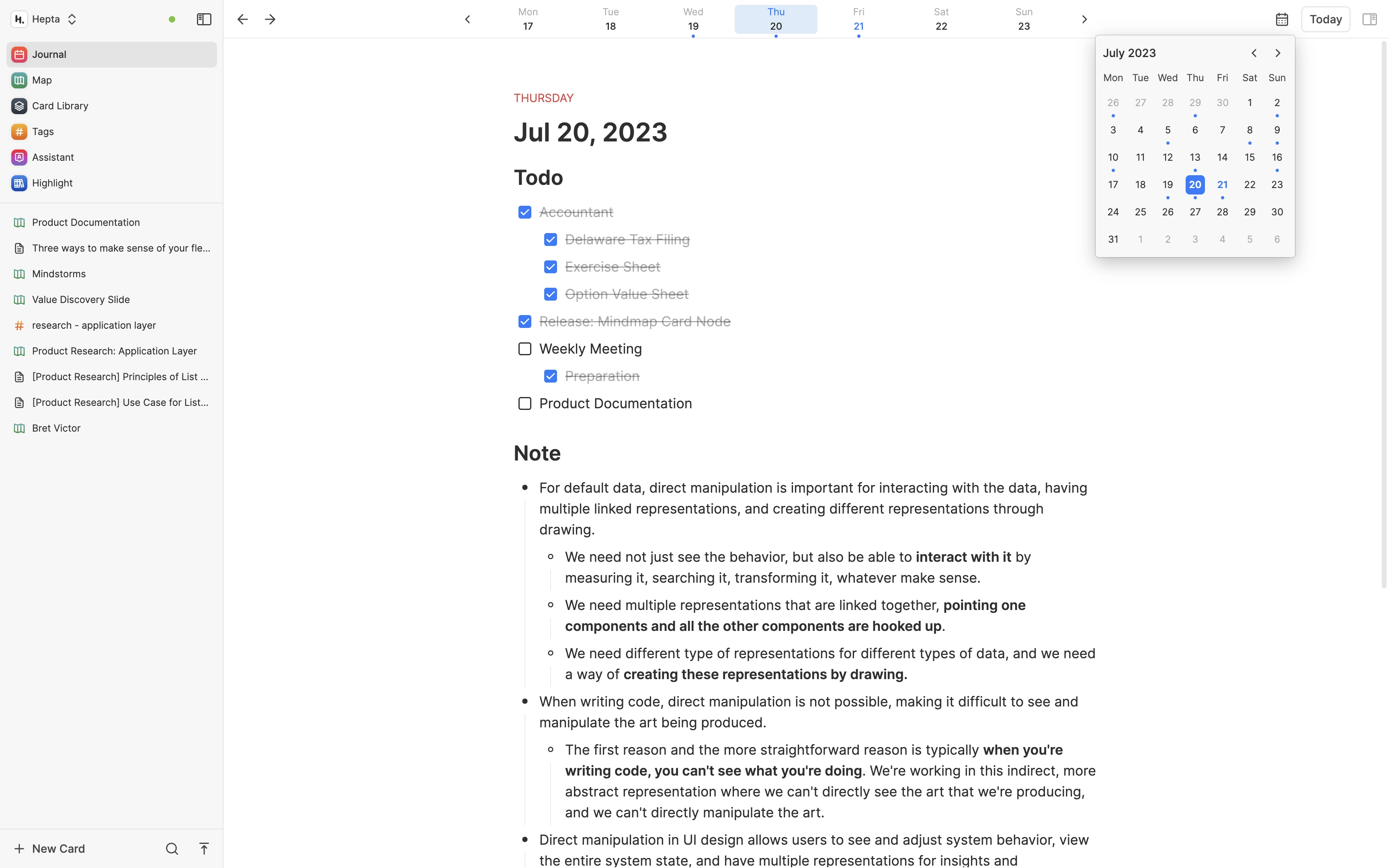
In Heptabase, there’s a dedicated application called Journal specifically designed for quick, stress-free recording. To enter this daily content storage space, simply click the first button on the left sidebar. You can jump to the desired date through the navigation bar and calendar on top.
The start of each day presents a blank input block, where you can quickly jot down inspired thoughts and ideas. These entries will be stored in the journal of that day. However, these entries won’t become cards just yet. They are more like stickies, diaries, or collection boxes, independent of your cards and whiteboard workspace. But if needed, you can transform the text in the journal into cards at any time.
One method is to use the block menu for transformation. Simply select the text you want to transform, click on the small block symbol on the left, and select Turn into new card then the selected text will be converted into a card. The first chunk of text will become the title of this card.
The original text on the Journal will then become a hyperlink that links to the new card.
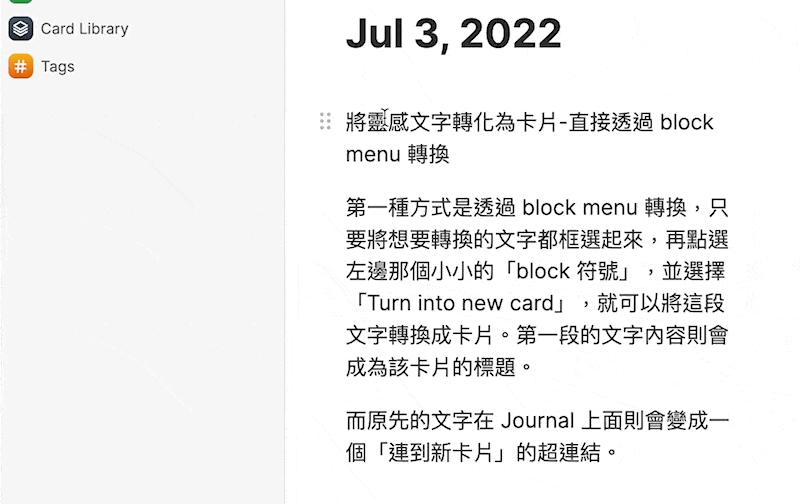
The second method is to drag the content block into the whiteboard. You can open the Journal from the upper right corner of any whiteboard. At this point, you can directly drag the desired text block onto the whiteboard, which will instantly convert this text into a card. The first block of text will become the title of this card.
The original text on the Journal will then become a hyperlink that links to the new card.
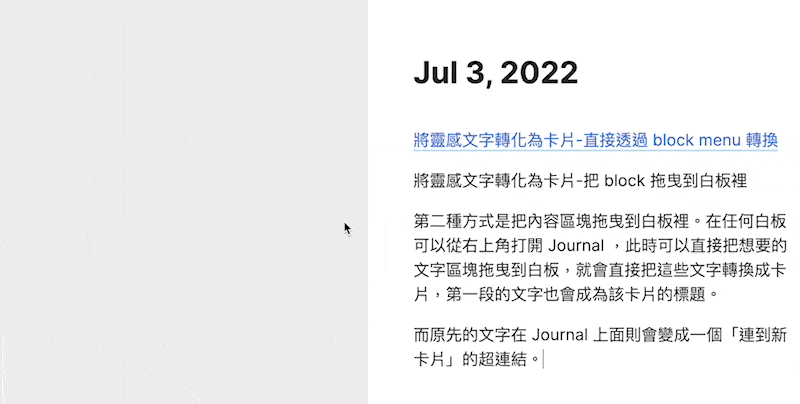
These two methods of converting “scattered text” into “cards” make the Journal an ideal first stop for jotting down inspirations and ideas in Heptabase.
But, in my opinion, the most practical aspect of the Journal in Heptabase is that it can directly form a Journal calendar according to the date.
For me, the biggest advantage of placing each journal onto the whiteboard is that I can quickly review the content I’ve recorded over the past few days or weeks. This is an experience I’ve never had with other journal tools I’ve used in the past. When I realized that I could see my past records at a glance, I no longer needed to carefully organize or edit metadata, and instead could focus more on recording and breaking down thoughts.
Therefore, I highly recommend everyone to record their daily thoughts and discoveries in the journal and place them on the whiteboard. This is the Heptabase feature I use most frequently.
Mobile App
Since September 2023, the Heptabase mobile app has undergone several updates, becoming increasingly mature and practical.
Upon opening the app, you can select Card Library, Whiteboard, or Tag. After selecting, you can see the associated cards and edit them, which is conceptually similar to using the computer or web version.
Additionally, the bottom tab includes three buttons for Journal, Search, and Add Card, facilitating quick access and recording of journal thoughts, card retrieval, and new card addition.
Currently, I believe the Heptabase mobile version provides the capabilities to quickly record on the go and to search and edit previous cards. This proves highly practical for scenarios where sudden inspirations need capturing while outdoors or when we desire to revisit a specific card.
What I am most looking forward to is the ability to directly read and highlight on the mobile phone. I’m sure the experience will be fantastic!
Reading, Highlighting, and Annotating in Heptabase: PDF & Highlight
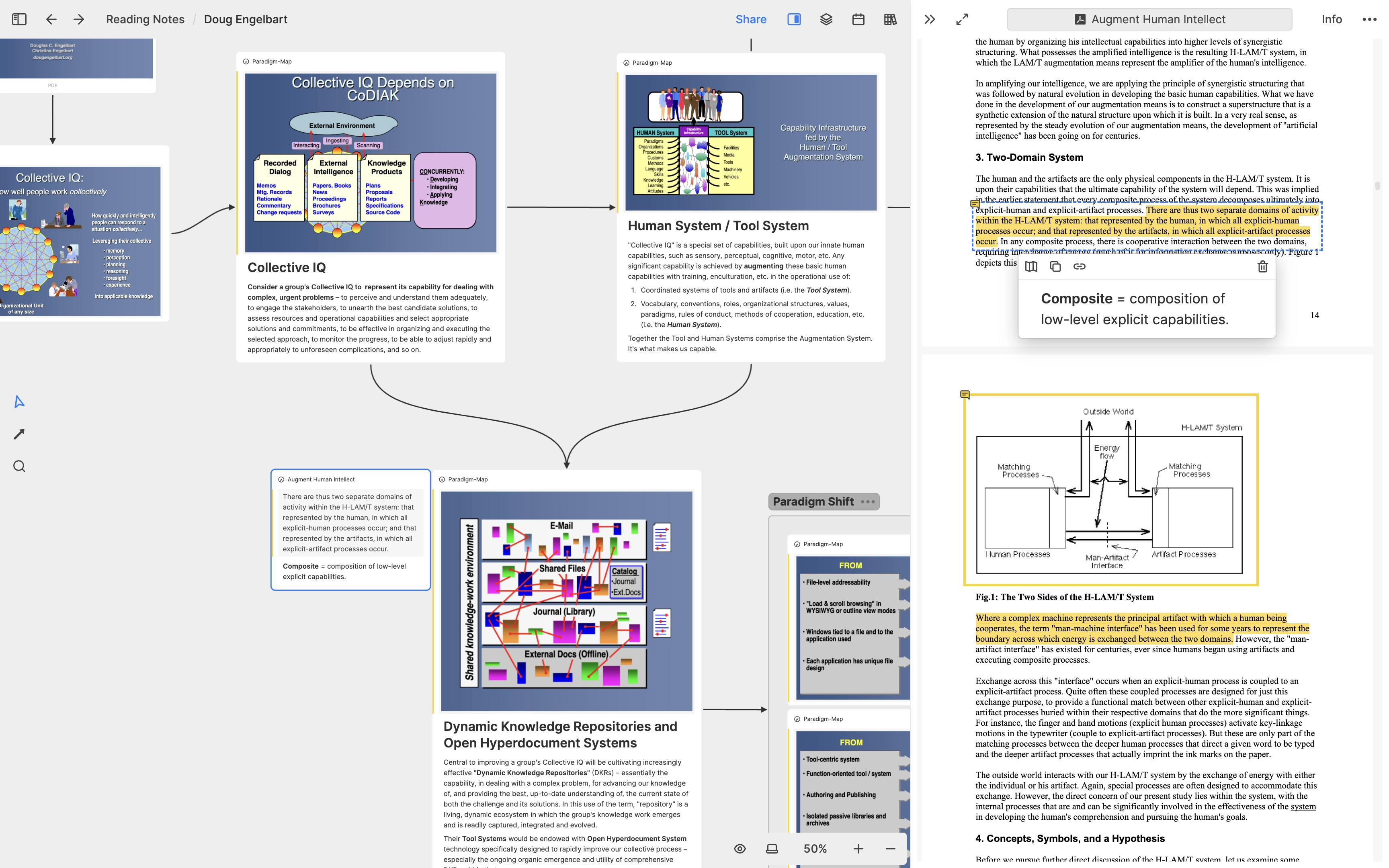
When it comes to reading and highlighting, Heptabase also offers a complete experience of PDF reading, highlighting, and annotating.
Currently, there are two highlighting modes provided for PDFs. One is text highlighting, and the other is area highlighting,” where you select an area directly. Both methods will generate a highlight, at which point you can change its color, write notes on it, link it with a card on the whiteboard, or embed it in the card itself.
In addition to PDF highlights, Heptabase also currently supports integration with Readwise. Once you’ve set up a Readwise connection, all the highlights generated on it will be synced to Heptabase, allowing you to establish connections with your existing whiteboards and cards.
Heptabase’s Multi-Platform and Web Versions
Currently, Heptabase offers versions across multiple platforms, including three different desktop operating systems: MacOS, Windows, Linux, two mobile operating systems: iOS and Android, as well as a Web version that can be used regardless of the operating system.
You can download the latest version of Heptabase on the Heptabase download page.
You can also click on “Log in” in the upper right corner of the official website, or directly enter https://app.heptabase.com to use an almost identical Web version to the desktop version.
For me, I use the Mac version more often because the shortcuts are less likely to conflict with the browser. However, I think the Web version has advantages in certain usage scenarios:
- When I want to open multiple instances of Heptabase, I can do so with just a browser. This is helpful in certain situations, such as opening a small window for quick note-taking or using side-by-side windows for comparison.
- When I want to use browser plugins, the Web version is also a good fit.
- In cases where standalone software can’t be downloaded, such as on public computers in libraries or offices, the Web version is also suitable (but remember to log out when done).
Heptabase’s Sync and Offline Usage
Sync
While using Heptabase across all mentioned platforms, enabling “Sync” allows you to enjoy almost real-time synchronization of your editing experience. For example, if you simultaneously open the Web version, Mac version, and mobile version, type a few words into your Journal; these words will appear in the other corresponding versions within fraction of seconds.
It’s not just limited to text; images, videos, or files will also quickly synchronize. You can therefore use Heptabase as a simple “cross-device data transfer” tool.
However, with the synchronization feature, the main concern is the issue of "sync conflicts." Suppose you initially edit a card in the Web version. Then you open the Mobile version and enter this card. But if the Mobile version has not yet fully synchronized the cloud version, and you edit new content. Because the timestamp of the Mobile version has updated, it can overwrite the content in the Web version.
To address occasional occurrences of this scenario, Heptbase’s current handling mechanism is the “version history” feature. If you open the menu of each card or Journal log, you will see this page. Upon entering, you will see the edit record at different times and on different devices.
Please refer to this Wiki tutorial for further explanation: How does version history work in Heptabase?。
Offline Usage
In addition to fully use Heptabase online, Heptabase also allows you to use it offline or deactivate sync completely. While using the desktop version of Heptabase, the relevant data will also be stored on your computer, so you can continue to use Heptabase smoothly and normally even if you suddenly go offline. When the connection is restored, it will synchronize the latest status with the cloud data again.
On the other hand, some people prefer not to synchronize their data to the cloud in some certain situations. This could be due to company security policies or their own highly private and confidential information. In this case, you only need to disable sync in the settings, and Heptabase will completely delete the cloud data. Afterward, all usage will become a purely standalone software.
However, this approach is only limited to use on a single device. Currently, Heptabase does not provide multi-device offline use with a single account.
Backups, Exportation, and Sustainability of Heptabase
The synchronization mentioned earlier will continually sync the latest version of the data with the cloud, but Heptabase also provides a complete “local backup” feature. Each time you close Heptabase, the system automatically creates a zip file that contains a .json file, covering the entire Heptabase database. So if you want to restore to a particular version, you can directly restore from the backup file.
However, as the data grows, the backup files will also grow larger. Therefore, I usually clean up my backup folder about every two weeks.
In addition to backups, Heptabase also offers a comprehensive manual data export function. By selecting Export Now in the settings, a zip file will be generated, exporting all notes, mindmaps and boards in the markdown format, including related pictures, videos, and PDF files.
For me, both the automatic backup and manual export functions of Heptabase serve as a form of “peace of mind insurance,” allowing me to accumulate data more confidently.
Beyond this, there is an even larger risk: “the company goes out of business, and the product is discontinued.” For this risk, Heptabase provides an explanation in its official wiki, with two main points:
- Currently, Heptabase’s operation status is stable, and there is sufficient cash, so there are no operational risks in the short term.
- Even in the worst-case scenario, if Heptabase shuts down, the team will open-source the Heptabase code, allowing users to continue using it.
Heptabase Pricing
Since launching version 1.0 on August 31, 2023, Heptabase has two pricing plans:
- Annual subscription, paid once a year, with a one-time payment of $107.88 USD, which equals to $8.99 USD per month.
- Monthly subscription, paid every month with each month costing $11.99 USD.
No matter which payment plan you choose, a seven-day free trial is available when registering a new account. This trial requires a credit card number. No charges will be made immediately after entering the card number, but payment will be deducted according to your chosen plan once the seven-day trial period ends.
I myself subscribed to Heptabase more than a year ago when its features were quite basic. Even then, I felt it was a bargain. Now, Heptabase has more comprehensive features and offers a better user experience. It has become an indispensable learning tool and the core of my knowledge management process. I believe that the returns it provides far exceed the monthly cost I pay for it.
Thus, I highly recommend everyone to subscribe and give it a try!
You can start a 7-day free trial with this link.
Conclusion: The core value of Heptabase lies in its ability to streamline workflows between different functions
Due to the length of this article, I can only briefly introduce a few key features that Heptabase currently has. However, for me, the core value of Heptabase lies in its “workflows,” which seamlessly interconnect these features.
For instance, I can jot down an idea in the Journal every day and then pour it into the whiteboard on weekends to create a mindmap and cards. Alternatively, I can read a new PDF in Heptabase and add the extracted knowledge concepts to an existing whiteboard, followed by recording my ideas.
Heptabase offers a variety of capabilities. As you grow familiar with the software, you can combine these capabilities to form new combination capabilities and achieve more goals through these abilities.
Whether it’s studying, researching, planning, organizing information, or noting down inspirations, I find it smooth to perform all these tasks in Heptabase. It’s easy to enter a state of flow, and it’s also easy to generate a sense of accomplishment by realizing that I’ve completed certain tasks.
In addition, as you continue to accumulate cards and reinforce memory through fixed visual positions, there’s a sense of relief. Knowing that the thoughts and knowledge you’ve gathered are right there, easy to find and connect, provides a certain peace of mind.
This is a sensation that I’ve rarely felt while using many note-taking and writing tools, but after using Heptabase, I feel continuously “empowered,” as it brings more possibilities and gains.
This article is only a starting point. I will introduce more unique features of Heptabase and different functional workflows in the future. Before that, you can refer to the Public Wiki’s detailed introductions. The Public Wiki contains a tons of tutorials which are highly recommended as they are applicable even without using Heptabase.
Lastly, feel free to contact me at [email protected] to discuss anything regarding Heptabase.
I look forward to having you experience Heptabase after reading this preliminary introduction, and I hope you gain benefits and realize its value!
If you have anything you want to discuss, feel free to contact me at [email protected]
